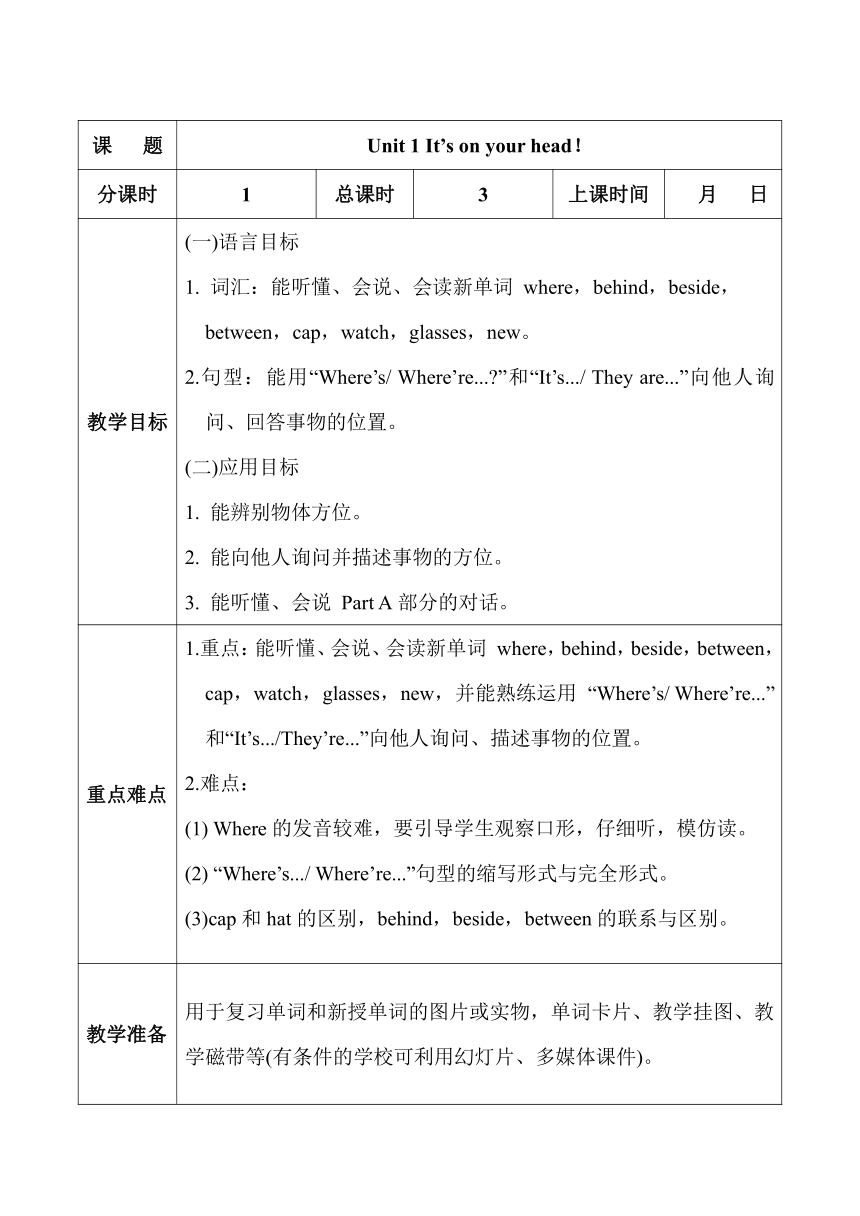
课 题 Unit 1 It’s on your head! 分课时 1 总课时 3 上课时间 月 日 教学目标 (一)语言目标1. 词汇:能听懂、会说、会读新单词 where,behind,beside,between,cap,watch,glasses,new。2.句型:能用“Where’s/ Where’re... ”和“It’s.../ They are...”向他人询 问、回答事物的位置。(二)应用目标1. 能辨别物体方位。2. 能向他人询问并描述事物的方位。3. 能听懂、会说 Part A部分的对话。 重点难点 1.重点:能听懂、会说、会读新单词 where,behind,beside,between, cap,watch,glasses,new,并能熟练运用 “Where’s/ Where’re...”和“It’s.../They’re...”向他人询问、描述事物的位置。2.难点:(1) Where的发音较难,要引导学生观察口形,仔细听,模仿读。(2) “Where’s.../ Where’re...”句型的缩写形式与完全形式。(3)cap和hat的区别,behind,beside,between的联系与区别。 教学准备 用于复习单词和新授单词的图片或实物,单词卡片、教学挂图、教学磁带等(有条件的学校可利用幻灯片、多媒体课件)。 教 学 程 序 设 计 Step1热身/复习(Warm-up/Revision)1. Greetings and free talk.How are you Nice to meet you! What’s your name 2. Game: Guess教师手拿一顶帽子置于身后,露出一点点,让学生猜猜。What’s in my hand What colour is it Is it in my left hand or in my right hand 猜中的学生可帮小组赢得加分的机会。Step2新课呈现( Presentation)1.情境创设:找物品。(1)紧接上面的“猜猜”游戏,教师创设一个“找物品”的真实情境,学生初步感知方位。教师课前将多种不同颜色的帽子藏在教室里(预设 beside,behind, between, on, in, under等位置)T: There are some caps in our classroom.Please help me find them and tell me where they are.Where is the red cap S1: It’s in the desk.T: Where are the red caps S2: They’re in the desk.(教师先对方位一致的学生提问,同时呈现重点句型,带读 几遍。)板书:Where’s my cap It’s in the desk.Where’re my caps They are in the desk. New words (1)beside, behind, between. ①利用原声带的地道发音带读。 (预测:难点是 between的发音/tw/,可比较单词 twenty, twelve的发音,教师应讲解发音的位置和方法。) ②利用 chant和手势记忆新单词 beside,behind,between Be be be beside(手势),one,two; Be be be behind(手势),one,two,three; Be be be between(手势),one,two,three,four; We’re friends(手势), we’re friends. 动一动:复习方位介词in,on,under,继续学习方位 介词 beside,behind,between,设计“两手动一动”的活动。 教师告诉学生左手是地点,右手是物品。当教师说 其中的某个单词时,学生用两手表示出某物所在位置。 例如:in是将右手放到左手中,并用左手将右手包紧。 on是将右手放在左手上。 under是将右手放在左手底下。 behind是将右手放于左手后。 beside是将右手放于左手旁 边。 between是将右手、左手平行放,物品改成头,头前 倾,放于两手之间。 ③利用新单词的图片或实物说句子(学生分组比赛)。 The boy is beside the tree. The boy is behind the tree. The boy is between the trees.(强调此处trees的复数形式。) (提示:学生边看书边说,提醒学生要有文本意识。) (2)cap, watch, glasses. ①逐个出示单词卡片,板书并带读。 (预测:cap和hat中字母a的发音相同,可同时学习操练,并进行辨析。 glasses中/g/的发音是难点,应引导学生观察口形,仔细模仿。)②看动作,猜单词。 ③学生上台将单词卡片放在人们常佩戴的相应位置,并引导学生用已学的单词和句型介绍物品的位置。 例如: Where ... ...
~~ 您好,已阅读到文档的结尾了 ~~